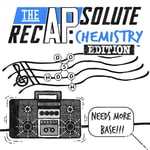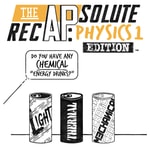The APsolute RecAP: Chemistry Edition – Détails, épisodes et analyse
Détails du podcast
Informations techniques et générales issues du flux RSS du podcast.

The APsolute RecAP: Chemistry Edition
Melanie Kingett, Sarah Rayder, Brad Kingett, Zach Caruso
Fréquence : 1 épisode/9j. Total Éps: 63

Classements récents
Dernières positions dans les classements Apple Podcasts et Spotify.
Apple Podcasts
🇨🇦 Canada - courses
16/05/2025#90🇨🇦 Canada - courses
15/05/2025#65🇺🇸 États-Unis - courses
26/04/2025#68🇺🇸 États-Unis - courses
25/04/2025#51🇺🇸 États-Unis - courses
24/04/2025#53🇺🇸 États-Unis - courses
22/04/2025#54🇺🇸 États-Unis - courses
21/04/2025#71🇺🇸 États-Unis - courses
20/04/2025#59🇺🇸 États-Unis - courses
18/04/2025#99🇺🇸 États-Unis - courses
17/04/2025#65
Spotify
Aucun classement récent disponible
Liens partagés entre épisodes et podcasts
Liens présents dans les descriptions d'épisodes et autres podcasts les utilisant également.
See all- https://www.instagram.com/theapsoluterecap
255 partages
- https://twitter.com/apsoluterecap
248 partages
- https://www.facebook.com/theapsoluterecap
208 partages
Qualité et score du flux RSS
Évaluation technique de la qualité et de la structure du flux RSS.
See allScore global : 68%
Historique des publications
Répartition mensuelle des publications d'épisodes au fil des années.
The APsolute RecAP: Chemistry Edition - Episode 62: Molecular Structure and Acid Strength
Épisode 62
lundi 31 janvier 2022 • Durée 10:50
All hydrohalic acids, but hydrofluoric acid, are strong acids. Why is that (0:31)? Strong acids fully dissociate and have a large Ka, weak acids only dissociate to a small percentage (1:20). When looking at strength, we are comparing the stability of the conjugate acid/base pair partners (2:00). For binary acids across a period (2:37) as well as down a group (3:09) electronegativity determines acid strength. For oxyacids, we can compare acids with different numbers of oxygen atoms, which affects the inductive effect, as well as resonance structures (4:58). We can also discuss acid strength across a period (6:44) and down a group (7:34). Bases are proton acceptors. Common bases are conjugate bases of weak acids, like carboxylic acids, and amines (7:53).
Question of the Day: Acid A has a Ka = 3.5 x 10-8, acid B has a Ka = 1.2 x 10-2. Which acid is HClO, which one is HClO2?
Thank you for listening to The APsolute RecAP: Chemistry Edition!
(AP is a registered trademark of the College Board and is not affiliated with The APsolute RecAP. Copyright 2022 - The APsolute RecAP, LLC. All rights reserved.)
Website:
EMAIL:
Follow Us:
The APsolute RecAP: Chemistry Edition - Episode 61: Unit 7 Selected FRQs
Épisode 61
lundi 24 janvier 2022 • Durée 12:04
The FRQ questions on the AP exam often combine content from two or three different units. In today’s episode, we are emphasizing questions that require knowledge and skills from Unit 7: Equilibrium. You will rarely find an FRQ that solely focuses on Unit 7, since it lays the foundation for Unit 8, acids and bases as well as parts of Unit 9, Application of Thermodynamics. It also links back to concepts from earlier units, like gas laws. The questions we are using today are online accessible. Our suggestion: Answer the questions yourself and then listen to this episode to hear the explanations, as well as do’s and don'ts for answering questions of Unit 7. We will review 2016 - Question 6, 2015 - Question 4 and 2014 - Question 4. These are released FRQs from previous exams and copyright of the College Board.
Thank you for listening to The APsolute RecAP: Chemistry Edition!
(AP is a registered trademark of the College Board and is not affiliated with The APsolute RecAP. Copyright 2022 - The APsolute RecAP, LLC. All rights reserved.)
Website:
EMAIL:
Follow Us:
The APsolute RecAP: Chemistry Edition - Episode 52: Deviation From Ideal Gas Law
Épisode 52
lundi 18 octobre 2021 • Durée 07:42
Teachers wish students would always behave ideal, but in reality life happens and it gets messy (0:32). The same is true for gases: There is a difference between real and ideal gases (1:12). The Ideal Gas Law assumes that particles don’t experience intermolecular forces nor that they take up volume (1:34). But real gases do and this leads to deviations from the Ideal Gas Law, especially under high pressure and close to condensing (2:00). Under low temperatures, intermolecular forces become more and more significant (2:41), leading to a lower pressure of a real gas compared to an ideal gas (3:30). This is enhanced by the strength of intermolecular forces and therefore their polarity (4:36). Because particles do have volume, the usable space is less in a real gas than an ideal gas (5:12). Therefore at high pressures the volume of a real gas is larger than the volume of ideal gases (5:32).
Which molecule would have the least deviation from the Ideal Gas Law?
A. CH4 B. Ne C. H2O D. Cl2
Thank you for listening to The APsolute RecAP: Chemistry Edition!
(AP is a registered trademark of the College Board and is not affiliated with The APsolute RecAP. Copyright 2021 - The APsolute RecAP, LLC. All rights reserved.)
Website:
EMAIL:
Follow Us:
The APsolute RecAP: Chemistry Edition - Episode 51: Types of Solids and Their Properties
Épisode 51
lundi 4 octobre 2021 • Durée 10:01
Sitting in your room, you might have salted peanuts as a snack, a pencil, tea with sugar and you listen to this episode with earphones in (0:31). Sodium chloride, sugar, graphite and copper represent four types of solids. Sodium chloride is an ionic solid with low vapor pressure, high melting points and high boiling points, because of the strong attractive forces. Sugar is a molecular compound with low melting points due to weak IMFs (1:22). Graphite is an example of a network covalent solid (5:29), which generally have high melting points. Copper is representative of a metallic solid, which are good conductors of heat (6:44), ductile and malleable (7:06). Homogenous mixtures of metals are alloys (7:21).
Which of the following could be the identity of a solid that exhibits the following properties: it melts at 2973°C; it doesn't conduct electricity as a solid nor as a liquid.
A. ionic B. covalent C. covalent network D. metallic
Thank you for listening to The APsolute RecAP: Chemistry Edition!
(AP is a registered trademark of the College Board and is not affiliated with The APsolute RecAP. Copyright 2021 - The APsolute RecAP, LLC. All rights reserved.)
Website:
EMAIL:
Follow Us:
The APsolute RecAP: Chemistry Edition - Selected Unit 1 and 2 Free-Response Questions
Épisode 50
lundi 27 septembre 2021 • Durée 12:56
The FRQs discussed in this episode are 2008 - Question 2 and 5 as well as 2019 question 5. These are released FRQs from previous exams and copyright of the College Board (0:22).
Question 2 of the 2008 focuses on the experimental approaches, first the determination of the formula of a hydrate (2:06) and then gravimetric analysis (3:33). Question 5 of the 2008 exam starts with questions about ionization energies for fluorine in comparison with oxygen and xenon. The second part of the question asks for Lewis Diagrams of xenon compounds (7:59), the geometric shape (8:25) as well as hybridization (8:35) and polarity (8:55).
Question 5 of the 2019 exam provides a PES spectrum, which you will use to determine the electron configuration and identity of the element (9:08) and asks you to calculate the wavelength needed to remove an electron from the valence shell (10:01).
True or false: I have to answer the FRQ Questions from 1 to 7 as well as a through last letter in order.
Thank you for listening to The APsolute RecAP: Chemistry Edition!
(AP is a registered trademark of the College Board and is not affiliated with The APsolute RecAP. Copyright 2021 - The APsolute RecAP, LLC. All rights reserved.)
Website:
EMAIL:
Follow Us:
The APsolute RecAP: Chemistry Edition - Lewis Diagrams and Formal Charges
Épisode 49
lundi 20 septembre 2021 • Durée 09:34
Lewis Diagrams give us information about the arrangement and bond order of compounds (0:23). There are four steps to write Lewis Structure: 1) Sum up available valence electrons (1:16), 2) write symbols and connect them with a single bond (1:57), 3) complete the octet for surrounding atoms (2:27), and 4) add remaining electrons as lone pairs on central atom (2:48).
Some elements, like hydrogen, boron and beryllium as well as elements in Period 3 and beyond are exceptions to the octet rule (3:24). Formal charges can be used to determine the best Lewis Structure (5:15). In our episode we discuss calculating the formal charge for two possible structures of CO2 (6:07).
Which two elements will never be in the center of a Lewis Structure?
Thank you for listening to The APsolute RecAP: Chemistry Edition!
(AP is a registered trademark of the College Board and is not affiliated with The APsolute RecAP. Copyright 2021 - The APsolute RecAP, LLC. All rights reserved.)
Website:
EMAIL:
Follow Us:
The APsolute RecAP: Chemistry Edition - Gravimetric Analysis
Épisode 48
lundi 13 septembre 2021 • Durée 08:52
Do you have your own bathroom? Then you might be familiar with soap scum, which is the result of a combination of having hard water and soap (0:44). To determine how hard water is, we can use gravimetric analysis, which is an experimental procedure used to determine the amount of a substance, for example an ion, by precipitating it from an aqueous solution (1:25). Basing off of the solubility rules (1:45), the episode describes the steps to precipitate the calcium carbonate with sodium carbonate (3:05) and briefly discusses how to calculate the water hardness (5:08) and calcium ion concentration (5:38). Experimental errors described in the episode discuss how the yield can be higher or lower than expected (6:01).
Question: Why does the sodium carbonate have to be in excess?
Thank you for listening to The APsolute RecAP: Chemistry Edition!
(AP is a registered trademark of the College Board and is not affiliated with The APsolute RecAP. Copyright 2021 - The APsolute RecAP, LLC. All rights reserved.)
Website:
EMAIL:
Follow Us:
The APsolute RecAP: Chemistry Edition - Empirical and Molecular Formulas
Épisode 47
lundi 6 septembre 2021 • Durée 09:24
Switching glucose and formaldehyde would be really bad (0:42)! So let’s make sure we know the difference between empirical and molecular formulas! Our episode starts with a definition of empirical formulas (1:20) and the comparison of ionic and molecular compounds (1:49). It briefly recaps the significance of a chemical formula (2:16) and then recaps the steps to calculate an empirical formula using glucose as an example (2:50). But what if you do not have a whole-number ratio right away (5:30) and how do you go from Empirical to Molecular Formula (6:14)? One specific type of calculation is the combustion analysis (7:11).
Question: What is the first step, if I have given grams of elements as part of the substance instead of % composition?
Thank you for listening to The APsolute RecAP: Chemistry Edition!
(AP is a registered trademark of the College Board and is not affiliated with The APsolute RecAP. Copyright 2021 - The APsolute RecAP, LLC. All rights reserved.)
Website:
EMAIL:
Follow Us:
The APsolute RecAP: Chemistry Edition - Test Taking Tips 2021
Épisode 46
lundi 3 mai 2021 • Durée 08:05
The episode discusses and compares the structure of the two exam formats: the paper exams in May and the digital exam in June (0:50). Differences between the administration of the digital exam and paper exam are described (1:11), especially the calculator policies (2:16). We are taking a quick look at timing, which is the same for the paper exam and the digital exam (4:26). Your last episode of the season ends with a quick recap of test taking tips for multiple-choice questions (4:57) as well as free-response questions (5:33). Good luck everyone!
Thank you for listening to The APsolute RecAP: Chemistry Edition!
(AP is a registered trademark of the College Board and is not affiliated with The APsolute RecAP. Copyright 2021 - The APsolute RecAP, LLC. All rights reserved.)
Website:
EMAIL:
Follow Us:
The APsolute RecAP: Chemistry Edition - FRQ Annotations
Épisode 45
lundi 26 avril 2021 • Durée 09:42
The FRQ section has 3 long and 4 short question sets which you will have 105 minutes to complete (0:52). Past free response questions are available on the College Board website. (1:32) Make sure you carefully read the question and answer directly with precise language. (2:59) For calculations, make sure you show all your work, use units throughout and report your answer with the correct number of significant figures. (6:16)
True or False: You are not allowed to bring a highlighter to mark information in the exam booklet.
Thank you for listening to The APsolute RecAP: Chemistry Edition!
(AP is a registered trademark of the College Board and is not affiliated with The APsolute RecAP. Copyright 2021 - The APsolute RecAP, LLC. All rights reserved.)
Website:
EMAIL:
Follow Us:



